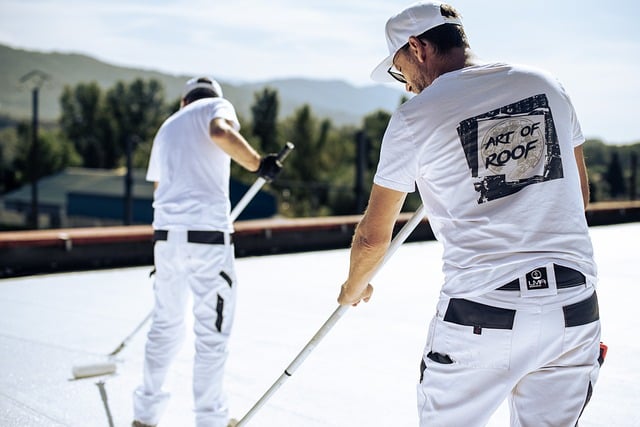Roofers play a critical role in preventing water intrusion at chimney and skylight junctions with the roof by maintaining and repairing flashings. These metal components are essential for redirecting water and safeguarding against leaks. A roofer's expertise is vital in identifying issues such as improper installation, material degradation, or thermal movement that can affect flashing performance. Early detection of these problems through regular inspections helps prevent more serious damage and costly repairs later on. Roofers must be adept at selecting appropriate materials and sealants for the local climate, ensuring long-term effectiveness. They use various types of flashings—step, kick-up, counter, and valley—customizing their application to fit the roof's design without disrupting its appearance. Adhering to industry standards and utilizing advanced technology, professional roofers provide watertight seals that protect the building's structural integrity, making routine inspections and maintenance by skilled roofers an indispensable aspect of property protection.
When it comes to safeguarding your home against water intrusion, the integrity of chimney and skylight flashing is paramount. This article delves into the nuances of maintaining and repairing these critical components by roofers specialized in such work. We explore common issues with chimney and skylight flashing, provide a step-by-step guide for inspection, and examine the range of materials used in flashing systems. Homeowners will find valuable insights on when to tackle repairs independently or seek professional assistance, the importance of proper sealing, and long-term maintenance strategies. Additionally, we address cost considerations, environmental impacts, and cutting-edge technology like thermal imaging in flashing inspections. With a focus on roofers’ expertise, warranty considerations, and safety implications, this comprehensive guide equips you with the knowledge to make informed decisions regarding your home’s flashing needs.
- Understanding Flashing Failures Around Chimneys and Skylights
- The Role of Roofers in Maintaining and Repairing Flashing
Understanding Flashing Failures Around Chimneys and Skylights

When chimneys and skylights intersect with a roofing system, their flashing components serve as critical barriers against water intrusion. A roofer’s expertise is pivotal in diagnosing failures in these flashings, which can stem from various causes such as improper installation, material degradation, or the natural expansion and contraction of materials due to temperature fluctuations. Identifying the root cause is essential for effective repair or replacement strategies. For instance, if the failure is due to a substandard sealant used during initial installation, a roofer might opt to remove the old flashing and apply a more durable and weather-resistant sealant. On the other hand, if the metal flashing has corroded over time, it may need to be replaced entirely with new material that is both resilient and compatible with the roof’s existing materials and design. Regular inspections by a proficient roofer can detect such issues early, preventing more extensive and costly damage to the home’s structure. Understanding the nuances of flashing failures around chimneys and skylights requires not only an awareness of the types of failure but also the knowledge to implement corrective measures that will stand up to the elements and protect the integrity of the roofing system for years to come.
The Role of Roofers in Maintaining and Repairing Flashing

When it comes to safeguarding a building from water intrusion, particularly around chimneys and skylights, roofers play a pivotal role in maintaining and repairing flashing—the metal pieces that bridge the gap between these protrusions and the main roof structure. Flashing is critical for preventing leaks as it redirects water flow away from vulnerable points where water could penetrate and cause damage. Roofers are trained professionals skilled in identifying compromised flashing due to wear, tear, or damage from extreme weather conditions. Their expertise lies in assessing the integrity of existing flashing, determining whether a repair or replacement is necessary, and employing the appropriate materials and techniques to ensure a watertight seal.
A roofer’s meticulous approach to this aspect of roof maintenance is essential for the longevity and structural integrity of a building. They work with various types of flashing, including step, kick-up, counter, and valley flashing, each serving unique purposes in different areas of the roof. The roofer’s role extends beyond physical repair; it includes selecting compatible materials that align with the roof’s existing profile and choosing appropriate sealants to endure the region’s specific climate conditions. By adhering to industry standards and utilizing modern tools and technologies, roofers effectively prevent water infiltration, thereby averting costly repairs and protecting the structural health of a building. Regular inspections and timely maintenance by professional roofers are key to ensuring that flashing remains resilient against the elements, preserving the safety and security of the home or structure it shelters.
Effective maintenance and timely repairs or replacements of flashing around chimneys and skylights are critical for safeguarding a structure’s integrity. Understanding the common failure points associated with these areas, as detailed in this article, empowers property owners and roofer professionals alike to address issues before they escalate. Regular inspections by experienced roofers play a pivotal role in ensuring that flashing remains watertight, thus preventing costly damage to the home’s interior. By prioritizing this aspect of roof maintenance, one can maintain the longevity and performance of their property’s roofing system. It is advisable to engage with professional roofers who possess the expertise necessary for proper flashing installation and repair, ensuring long-term protection and peace of mind.
